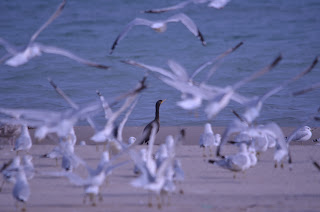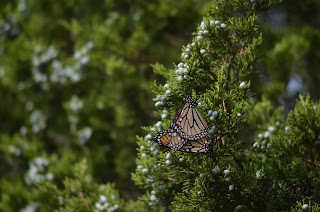I have been lucky enough to have spent 2 months already at Long Point and now that August has arrived the birds are starting to as well.
 |
| American Black Duck |
Long Point Bird Observatory is the largest banding station I know of in the world and I am lucky enough to be here for the start of fall migration.
On the way to the tip we saw American black ducks, great blue heron and a foresters tern.
On my first afternoon back at the tip I was carrying stuff back to the cabin and found a spiny softshell on the path. This hatchling turtle was probably only a few days old and about 2 inches long.
 |
| Hatchling Spiny Softshell Trtle |
I have gotten to see a lot of amazing birds such as:
Bald Eagle
 |
| Juvenile Bald Eagle |
Near Gravely Bay Road I saw four wood ducks in a shallow marsh pond.These ducks are quite magnificently decorated.
 |
| Wood Ducks |
 |
| Least Sandpiper |
I was walking through the grass and sedge higher up on the beach when I saw it. A tiny little thing with redish-brown on it's head and back with a white belly. I watched it poking around in the sand at the waters edge as it walked the same direction as I did. I cleverly walked quickly through the grass and without it noticing crouched down on the beach infront of it. Then it was just a matter of keeping still as it came closer. The excitement built with every step until it was about a metre away from me and I got the best look at a least sandpiper that I ever could imagine.
 |
| Least Sandpiper |
 |
| Sanderlings |
A walk along the South shore discovered a surplus of shorebirds including killdeer, least sandpipers and sanderlings. The sanderlings were often seen in small groups of about 3-8 birds. Six sanderlings were in a single group near the CWS property border.
These birds were not so bothered by me and I was able to watch them feed
along the shoreline for about half an hour.
 |
| Sanderling running away when I got a bit too close |
Ring billed gulls and a great blue heron surrounded a double crested cormorant and as I approached the heron flew.. then a few gulls took flight with a few more raising their wings as if to show they can fly. The cormorant stood still raising its stubborn head to the skies and not budging while I passed higher up on the beach.
 |
| Double Crested Cormorant in chaos |
A walk down to the tip was definitely needed with all of the birds coming in but I was only rewarded with a close up look at at great crested flycatcher.
 |
| Great Crested Flycatcher |
 |
| Mating Monarch Butterflies |
As well as birds, insects are beginning their migration as well. Dragonflies are zipping around in the evenings. Monarchs are starting their migration to Mexico and congregating at the tip. We have seen over 100 in a single day.
I was dropped off at the Breakwater station by a boat trip. A few days at breakwater resulted in more new birds for my year.
As with everywhere else in Ontario the fall wildflowers are blooming and the roads around breakwater were lined with flowers and hatched turtle nests.
 |
| Bouncing bet |
 |
| Common mullien |
 |
American Copper
|
 |
| Phragmites |
 |
| Sasafass tree |
 |
| Morning glory flower and vine |
 |
| House wren |
I embarked on a 20 km night walk down the south shoreline in search for amphibian life. This was a very nice night to walk and the amphibians were definitely plentiful. I stumbled across the largest American toad I have ever seen in my lifetime!
The oddest thing I found on my walk was a gray treefrog on the beach! I have never seen one of these frogs on a beach before but I guess at the tip anything can happen! I believe I've mentioned it before but these are my favorite frogs in Ontario by a landslide. All of the ones I saw were in the green morph.
Isn't it a cutie!
Here's a bunch of pictures of them! These amazing climbers with their enlarged toe pads looked very out of place to me sitting on the beach.
 |
| Gray treefrog (Hyla versicolor) |


























































